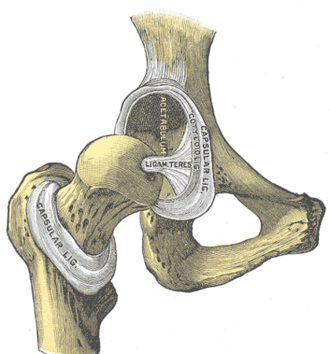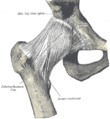Medicine:Ortolani test
| Ortolani test | |
|---|---|
| Medical diagnostics | |
 Hip-joint, front view. | |
| Synonyms | Ortolani maneuver |
| Purpose | exam developmental dysplasia of the hip |
The Ortolani test is part of the physical examination for developmental dysplasia of the hip, along with the Barlow maneuver.[1] Specifically, the Ortolani test is positive when a posterior dislocation of the hip is reducible with this maneuver.[citation needed] This is part of the standard infant exam performed preferably in early infancy.[citation needed]The Ortolani test is named after Marino Ortolani, who developed it in 1937.[2]
Procedure
The Ortolani test is performed with the Barlow maneuver and inspection of the hip joint and legs. It relocates the dislocation of the hip joint that has just been elicited by the Barlow maneuver.[3]
The Ortolani test is performed by an examiner first flexing the hips and knees of a supine infant to 90°, then with the examiner's index fingers placing anterior pressure on the greater trochanters, gently and smoothly abducting the infant's legs using the examiner's thumbs.[3]
Interpretation
A positive sign is a distinctive 'clunk' which can be heard and felt as the femoral head relocates anteriorly into the acetabulum:[4]
References
- ↑ US Preventive Services Task Force (March 2006). "Screening for developmental dysplasia of the hip: recommendation statement". Pediatrics 117 (3): 898–902. doi:10.1542/peds.2005-1995. PMID 16510673.
- ↑ Dwyer NS (June 1987). "Congenital dislocation of the hip: to screen or not to screen". Archives of Disease in Childhood 62 (6): 635–7. doi:10.1136/adc.62.6.635. PMID 3619484.
- ↑ 3.0 3.1 Parrales, Hugo (2017). "Maniobras de Ortolani y Barlow". https://cerebromedico.com/ortolani-y-barlow/.
- ↑ "Developmental dysplasia of the hip". American Family Physician 74 (8): 1310–6. October 2006. PMID 17087424. http://www.aafp.org/link_out?pmid=17087424.
External links
 |


